Written by: Rik
Date posted: December 8, 2012
Aside from the main business of churning out movies for profit, you can also get your hands dirty by getting involved in the creative process. As I mentioned in the main review, it’s probably best to explore this side of the game away from the career mode. But you’ll need to play the career mode first in order to unlock all the tools and facilities – the Advanced Movie Maker and Post-Production, in particular – necessary to harness your creative genius. Once you’ve done this, you can head to the sandbox mode, which gives you the freedom to make your movies away from the pressures of star and set management.
First off, use the Advanced Movie Maker to build your script. Name your movie, and the characters. We can cast the parts later. The choices for structure are ‘Standard’, ‘Detailed’ and ‘Freeform’ – the first two give you some guidance on the overall and scene-by-scene make-up of your movie, the third assumes you know what you want to be doing. I’ll choose ‘Detailed’, as I want to make a movie of reasonable length but, as I won’t be writing a story and will largely be making it up as I go along, I could do with some guidance from the game. I haven’t given it any thought, so I’m going to go for a generic action flick with an extremely unoriginal name.
Time to put together the movie now. First, choose a location (set) for your scene. You’ll then have a choice of a number of pre-set scenes on that set to include in your movie. To be clear: you don’t have free reign to place your actors in the scene, direct their actions, and move the camera around willy-nilly. Instead, the game gives you a choice of template scenes, over which you have a degree of control.
At this stage, the scenes are acted out by mannequins (as we haven’t cast any actors yet). The coloured mannequins are your stars and will normally be placed prominently in the scene. There are also wooden mannequins all over the place – these represent potential locations and actions for your stars or extras, so you can swap your actors into these positions, if you wish: otherwise, the wooden mannequins won’t be visible at all when you actually shoot the scene. In this chase scene, for example, we have a number of options for the placement of passers-by. We could also change the nature of the scene by replacing a coloured mannequin with a wooden one – thus turning a sequence with one actor chasing another into one where a single actor runs through the street. It’s with tricks like this – allied to some clever editing – that you can expand your options beyond what the pre-set scenes initially seem to offer.
So, we’ve hammered together a basic structure. Given that I’ve not really thought a story through, I’ll just elect to shoot sequences that I’d expect to see in a lazy action movie knockoff and that I’d like to include in this one. If you don’t have a good idea of how things are going to fit together, it’s probably worth planning to shoot a few more scenes than you need – you can always cut or omit them later. You’ll also need to make sure you’ve actually build the sets you need, if you haven’t already.
Before we go any further, it’s probably best to cast actors, so we can have a better idea of how the finished product will look while we’re putting together the script. As this is a vanity project, I may as well cast an idealised, much better-looking version of myself in the lead role. Such things are possible thanks to the Starmaker utility that comes bundled with the game. You can tinker looks, physique, experience, and all of the other attributes of a star here. Then, once you’re done, you just re-enter the main game, drag one of your stage school wannabes into the ‘Import Star’ area and, hey presto, they turn into the actor of your choice. You then cast the movie as you would in the main game, and then return the script to the Advanced Movie Maker.
Now we see our stars instead of mannequins. We can also set costumes for our heroes. There isn’t an awful lot of choice when it comes to the kind of outfit a plain-clothes detective might wear, so Stoo gets a suit, while my character’s dressed like a classic car enthusiast. With the actors in place, things start to come together. Dressing scenes with props proves rather fiddly, though, and after I spend ages getting some discarded bottles onto my character’s bedside table for the opening scenes, I resolve to ignore such things unless absolutely necessary. Some scenes allow you to vary their length, or adjust the behaviour of the actors (a conversation might have an amicable or angry conclusion, for example) so there are some tweaks to make here. Other than that, it’s just a case of making sure all the actors and extras are in the right place for each scene, and giving some more thought to how it’s all going to be cut together.
With everything in place, it’s time to start shooting. In sandbox you can just have movies made instantly, but it’s quite cool to watch the scenes you’ve mapped out actually being set up and filmed. The downside, though, is that a film of any significant real-life length takes absolutely ages to be shot. A Force for Bad takes 12 years to film, for an end product that comes in at under 7 minutes.
Once filming finishes, it’s time to move into post production, which is where the bulk of your work will be done. Lots of scenes need to be trimmed, and some need to cut altogether. I realise that my character is holding a different kind of gun in two consecutive scenes; I could re-shoot that scene, but in the end it’s not really needed, so I just cut it. I’ve also forgotten to include a computer on the desk of the office in a couple of scenes, so they’re out too. Other issues you can kind of gloss over: in the car chase scene, there was no option for the car to have a passenger, so if you look closely, Stoo is absent from that scene, even though he should be there. Fortunately it all happens quite quickly, so it’s not that obvious.
Once you’ve trimmed the movie down, you can add subtitles, dialogue and music, if you so wish. I’ve decided against recording dialogue, because it’s more labour intensive, and subtitles probably work best with this kind of thing anyway (although for this reason I can’t comment on how effective the in-game recording and lip-synching features are). Subtitles are quite easy to add, although if you cut the movie after you’ve added them, it all gets out of sync, which is annoying, because sometimes you need to see how the words fit the scene first (or maybe that’s just when you make the script up as you go along).
For the music, I decided to try and make some use of the half-finished tunes from the time my friend PG and I attempted to start a band (don’t ask). It seems quite well suited to action sequences, and salvaged the tube-chase scene, which I was particularly worried about, as it didn’t seem to work – until the distraction of ROCK was added. Getting the timing right was quite tricky though, and compounded by the fact that the graphical representation of the clips seemed to bear no relation to their actual length. So it’s a bit ragged in places.
Ultimately, though, I decided that it didn’t matter. You can’t polish a turd, as they say, and I had absolutely no creative ambition for A Force for Bad, other than as the end product of some investigation and tinkering to find out how the Advanced Movie Maker and Post Production bits of the game work. Even with such limited aspirations, though, the whole thing took bloody ages to put together, and that’s without writing a story or putting any real thought into it at all. If nothing else, it serves as a lesson (as if one were needed) that it can take quite a lot of hard work an effort to produce something really crap. Anyway, here’s the finished product:
Putting that aside for a moment, this area of The Movies does pretty much what it says on the tin in that it provides an accessible means of creating your own movies. Whether you could ever produce anything genuinely watchable with it is open to question, but it represents the fun, creative side of gaming in the same way that the likes of Stunts or Stunt Island might have done in the past. One thing’s for certain – if this had come out when I was a bored teenager, I would have loved it to bits.

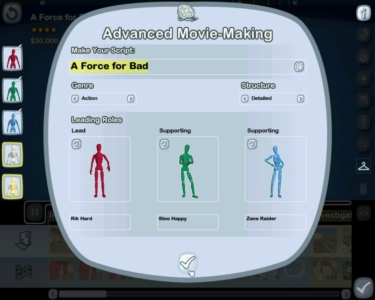
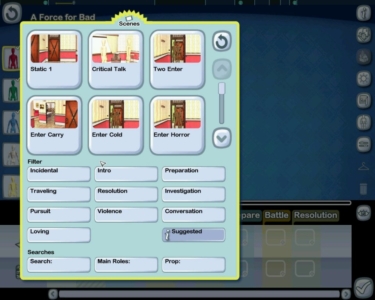
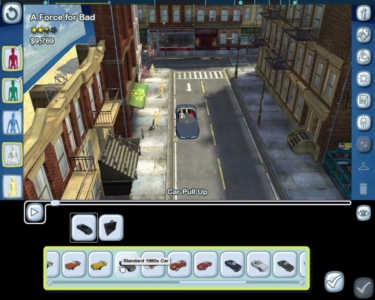
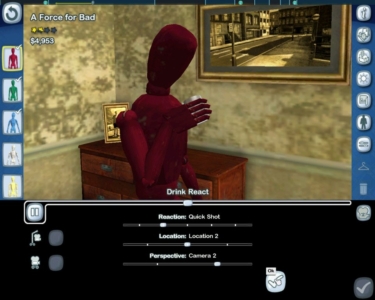
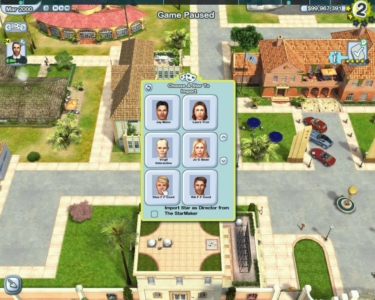
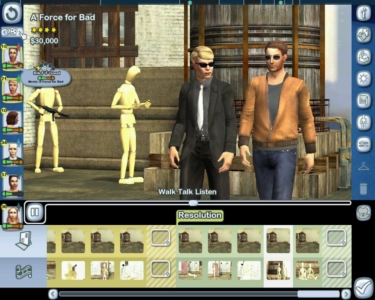
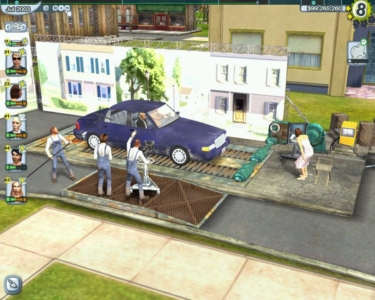
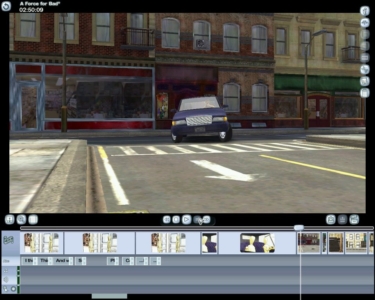
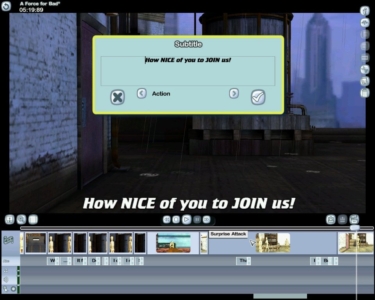
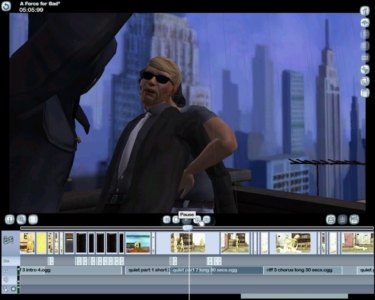

 Posts
Posts